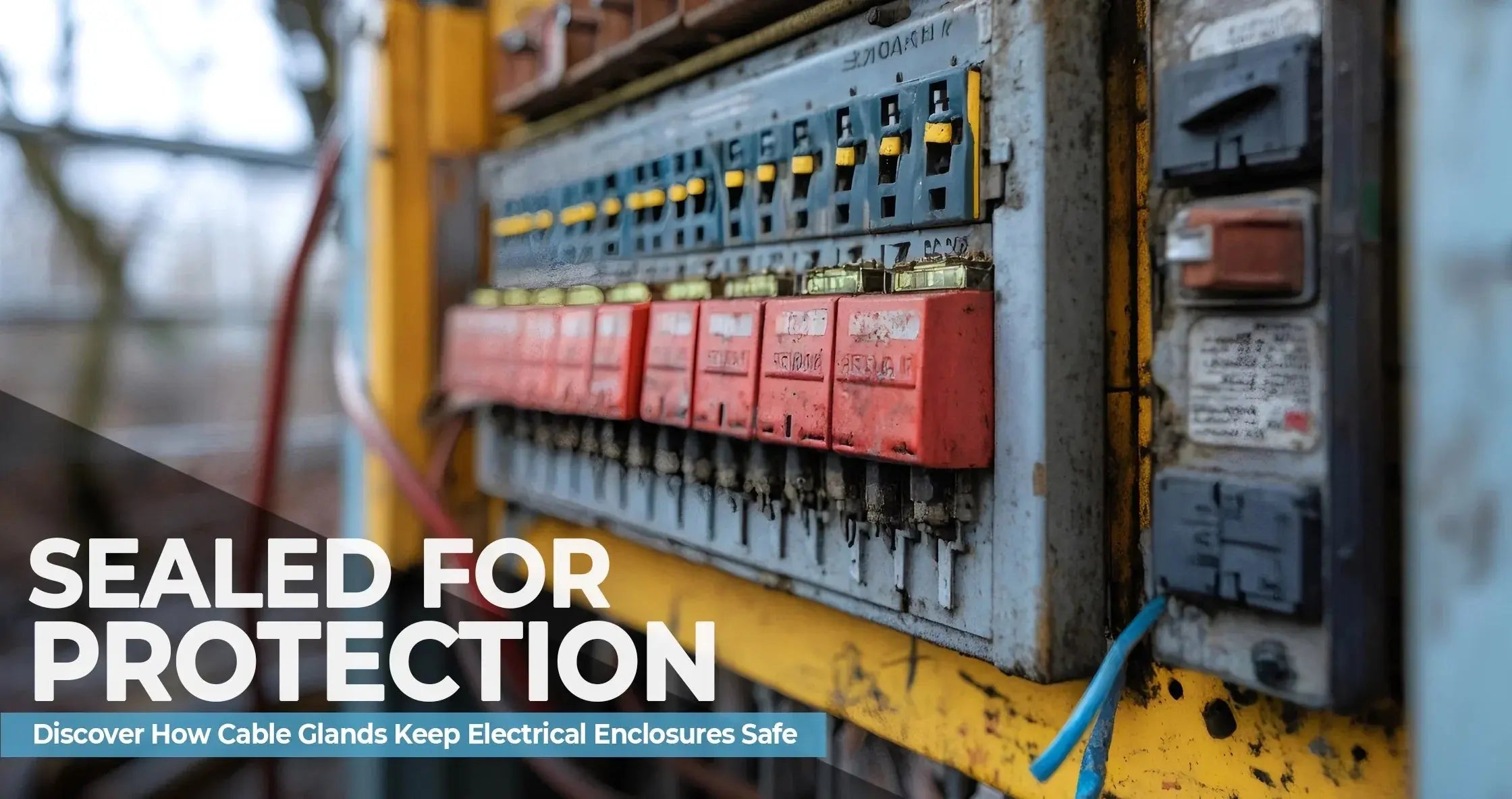In industrial and commercial electrical installations, keeping your system sealed and safe from environmental hazards is non-negotiable. Cable glands are among the most overlooked yet vital components in achieving this protection. Whether it's to prevent dust ingress, water exposure, or flammable gas hazards, choosing the right cable gland can make the difference between a secure connection and a compromised system.
What Is a Cable Gland?
A cable gland is a device designed to attach and secure the end of an electrical cable to equipment. It provides strain relief and connects by a means suitable for the type and description of cable for which it is designed. More importantly, cable glands provide sealing and environmental protection. They are integral to ensuring the integrity of enclosures, preventing contaminants from entering electrical panels and junction boxes.
Why Cable Glands Are Critical in Electrical Installations
The primary function of a cable gland is to act as a barrier between the cable and the external environment. In harsh industrial conditions, where machinery is exposed to water, dust, and chemicals, a cable gland ensures that the enclosure remains sealed. This helps prevent short circuits, corrosion, and electrical failures, thereby improving equipment lifespan and reliability.
In hazardous environments, especially in areas classified as explosive atmospheres (Ex areas), specific types of cable glands also play a role in explosion protection by maintaining the integrity of flameproof enclosures.
Types of Cable Glands
There are various types of cable glands designed for different cable types and environmental conditions. The most common types include:
-
Metal Cable Glands: Made from brass, stainless steel, or aluminum, these glands are used for industrial environments where mechanical strength and corrosion resistance are required.
-
Plastic Cable Glands: Typically made of polyamide or nylon, these are cost-effective and used in less demanding environments.
-
EMC Cable Glands: Designed to provide electromagnetic compatibility, reducing interference from external electrical sources.
-
Ex Cable Glands: Specially certified glands used in explosive environments, meeting strict international safety standards.
Understanding which cable gland suits your application is essential for ensuring safety and performance.
Key Features to Look For in a Cable Gland
When selecting a cable gland, key features to evaluate include:
-
Ingress Protection (IP) Ratings: IP ratings define the level of protection against solids and liquids. IP68-rated cable glands offer high resistance to dust and submersion in water.
-
Material Compatibility: Choose materials that match the mechanical and chemical requirements of your environment.
-
Cable Size Range: Ensure the gland supports the diameter of the cable you plan to install.
-
Seal Types: Consider single or double seal glands based on sealing needs.
These features contribute significantly to how effectively the cable gland shields the electrical enclosure from hazards.
How to Install a Cable Gland Properly
Installing a cable gland correctly is crucial. Poor installation can lead to leaks, strain on the cable, and eventual failure. The general installation steps are:
-
Select the Right Gland: Match it to the cable diameter and environmental requirements.
-
Strip the Cable Jacket: Carefully expose the required length of conductors.
-
Insert and Tighten: Slide the cable through the gland and tighten the compression nut to achieve a proper seal.
-
Check the Seal: Ensure the gland is tightly secured and no part of the cable is pinched or bent.
Manufacturer installation guides should always be followed to maintain safety and compliance.
Cable Gland Applications Across Industries
Cable glands are used in various sectors including:
-
Industrial Automation: Protects sensitive control and power cables in machinery.
-
Marine and Offshore: Prevents water ingress and corrosion in saltwater environments.
-
Oil and Gas: Ensures flameproof sealing in explosive atmospheres.
-
Renewable Energy: Maintains enclosure integrity in solar and wind installations.
-
Telecommunications: Shields fiber optic and communication cables from moisture and interference.
Each application demands specific cable gland types and materials to handle the unique stresses of its environment.
Benefits of Using Cable Glands
The use of cable glands delivers numerous benefits, including:
-
Environmental Protection: Shields against dust, dirt, water, and chemical ingress.
-
Strain Relief: Prevents mechanical stress on cables, reducing wear and tear.
-
Compliance: Helps meet international safety and installation standards.
-
Electrical Safety: Reduces the risk of shorts and fire hazards.
A well-installed cable gland contributes significantly to overall system resilience and longevity.
Choosing the Right Cable Gland: A Step-by-Step Guide
-
Determine the Application: Indoor or outdoor? Explosive or safe area?
-
Select the Right Material: Brass for industrial, nylon for commercial, stainless steel for corrosion resistance.
-
Verify Cable Type and Size: Shielded, armored, or unarmored?
-
Check Certification Requirements: Especially for hazardous zones.
-
Evaluate Environmental Conditions: Exposure to UV, chemicals, vibration, or water.
Following this guide ensures that the selected cable gland aligns with your operational needs.
Cable Gland Standards and Certifications
To ensure reliability and safety, cable glands are manufactured to meet various global standards:
-
IEC 60079: For equipment used in explosive atmospheres.
-
EN 62444: European standard for cable glands.
-
UL 514B: U.S. safety standard for fitting connectors.
Choosing cable glands that comply with these standards ensures compatibility and safety in international applications.
Maintenance and Inspection Tips
Even with a robust cable gland installed, regular inspection is essential. Look for:
-
Signs of wear or cracking
-
Loosened compression fittings
-
Cable movement or slippage
-
Corrosion around the gland body
Periodic maintenance helps extend service life and ensures continuous protection of your electrical enclosures.
Common Cable Gland Mistakes to Avoid
-
Using the wrong gland for the cable type
-
Ignoring IP rating requirements
-
Over-tightening or under-tightening
-
Failing to inspect after installation
Avoiding these pitfalls ensures your cable gland installation remains effective and compliant.
Conclusion: Protecting Your System Starts at the Entry Point
A cable gland might seem like a small component, but its impact on the protection and performance of an electrical enclosure is immense. By understanding the types, installation methods, and maintenance requirements of cable glands, you can ensure a safer, longer-lasting electrical system.
Whether you're working on industrial machinery, marine applications, or solar installations, the right cable gland can be the difference between costly downtime and a well-protected system. Don’t overlook this critical piece of your electrical infrastructure.


